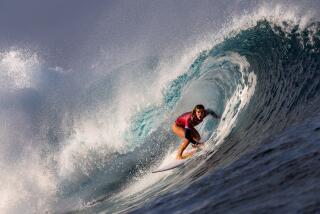Surfers Will Chase Big Waves, Big Bucks
The idea of offering a cash reward to the rider of the biggest wave of the winter is not a new one, but swell.com, a San Clemente-based action-sports Web site, has taken the notion to new heights.
The ante has been upped to $60,000, the single biggest cash prize in surfing history. Carlsbadâs Taylor Knox won $50,000 when he was captured on film riding a 48-foot monster at Todos Santos island off Ensenada to win the K2 Big Wave Challenge in 1998.
The potential wave size has increased as well. This big-wave award is open to tow-in surfers as well, which means wave-riders propelled into gigantic mountains of water by jet skis will certainly make Knoxâs effort seem puny.
Sixty-foot waves? Eighty-foot waves? The latter is the estimated size of the unofficial biggest wave ever ridden by Hawaiian Ken Bradshaw in 1998 at an outer reef off Oahuâs North Shore.
Mauiâs Laird Hamilton has become one of the best-known surfers because of video and magazine pictures of the enormous waves he has been slung into by watercraft at a spot called Jaws, off the northwest coast of Maui.
The contest begins Nov. 15 and ends March 15, 2001, and is confined to the North Pacific. Entries must be submitted in still photo or video formats and will be judged by a panel comprised of swell.com editorial staff members, surf magazine editors and big-wave surfers not in contention. Entries will be available for viewing on the Web site as they arrive.
âIn the course of any given winter, there are so many epic rides on mammoth waves that it almost defies logic to award just one,â said head judge Bill Sharp, publisher of Costa Mesa-based Surf News and contest director of the K2 event. âBut the advances in big-wave surfing almost demand that we do this. The boundaries are being pushed beyond what we ever thought possible.â
There were worries that someone would kill himself chasing the cash when K2 announced the first contest in 1997, and the stakes and waves will be higher this time. But Sharp thinks tow-in surfing in colossal conditions is safer than paddling into slightly smaller waves.
âYouâve got this expert jet skier whose only job is to watch you and swoop in to rescue you if you need assistance,â he said. âThereâs always the risk of being held under or being hit so hard by the wave that youâre injured, but itâs great to have a power assist right there.â
More to Read
Go beyond the scoreboard
Get the latest on L.A.'s teams in the daily Sports Report newsletter.
You may occasionally receive promotional content from the Los Angeles Times.










